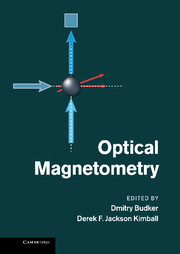Book contents
- Frontmatter
- Contents
- List of contributors
- Preface
- Part I Principles and techniques
- Part II Applications
- 13 Remote detection magnetometry
- 14 Detection of nuclear magnetic resonance with atomic magnetometers
- 15 Space magnetometry
- 16 Detection of biomagnetic fields
- 17 Geophysical applications
- Part III Broader impact
- Index
16 - Detection of biomagnetic fields
from Part II - Applications
Published online by Cambridge University Press: 05 May 2013
- Frontmatter
- Contents
- List of contributors
- Preface
- Part I Principles and techniques
- Part II Applications
- 13 Remote detection magnetometry
- 14 Detection of nuclear magnetic resonance with atomic magnetometers
- 15 Space magnetometry
- 16 Detection of biomagnetic fields
- 17 Geophysical applications
- Part III Broader impact
- Index
Summary
Sources of biomagnetism
Magnetic fields arise from many parts of the body and are produced by two distinct types of sources–ionic currents and magnetic tissues. Although most of the body is weakly diamagnetic, the magnetic tissues of greatest interest are paramagnetic or ferromagnetic. The major source of paramagnetism in the body is the liver, which contains iron compounds [1]. The strongest sources of ferromagnetism in the body are ingested or inhaled ferromagnetic substances, which can be detected even in trace amounts [2].
Like other electrical currents, ionic currents generated by nerve and muscle tissue produce magnetic fields and potential differences, which can be detected at the body surface or even outside the body. The ionic current has two components – a “primary” current and a “volume” current [3] (Fig. 16.1). Primary currents result directly from physiological activity and are confined largely within the electrically excited cells. Volume currents are passive return currents that extend far into the surrounding medium in response to the electromotive forces that drive the primary currents. Bioelectric signals are conducted to the body surface by volume currents and are the main source of electroencephalographic (EEG) and electrocardiographic (ECG) signals. Bioelectric signals are strongly influenced by the highly inhomogeneous electrical conductivity of the body. In contrast, biomagnetic signals arise predominantly from primary currents and are affected to a much lesser extent. This accounts for a key advantage of biomagnetic versus bioelectric fields – their simpler signal-transmission properties – which enables a more accurate determination of source location.
- Type
- Chapter
- Information
- Optical Magnetometry , pp. 303 - 318Publisher: Cambridge University PressPrint publication year: 2013

